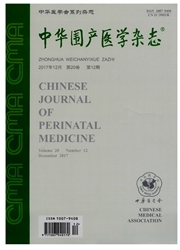

 中文摘要:
中文摘要:
目的 探讨角化细胞生长因子(keratinocyte growth factor,KGF)在高氧新生鼠以及地塞米松干预肺组织的表达与作用。方法 将3dSD新生鼠随机分为高氧组(95%氧)、高氧+地塞米松(简称地塞米松组)和正常组;HE染色观察肺组织形态结构,做辐射状肺泡计数;免疫组化检测KGF表达。结果 (1)高氧组可见肺泡壁较薄、结构简单化、肺泡大小不均,有些肺泡融合、体积增加,地塞米松组除具有上述高氧组特征外,肺组织结构明显紊乱,部分肺泡壁及间隔破坏;高氧组(9.50±1.05)和地塞米松组(10.03±3.25)辐射状肺泡计数值较正常组(13.00±1.79)减少(P均〈0.05)。(2)KGF阳性细胞显色部位在胞浆,显色细胞呈圆形,阳性细胞分布在肺间隔,肺泡周围呈散在分布,靠近支气管处阳性细胞较为集中,有些密集分布。各级支气管及小血管部位未见阳性显色。高氧组和地塞米松组肺组织除了较厚肺间隔偶见散在数个细胞显色外,整个肺组织几乎见不到阳性细胞。结论 新生鼠3~10d暴露于高氧环境(95%),可导致肺泡化停滞,肺组织KGF表达被抑制,地塞米松可加重肺部病理改变,KGF表达抑制可能是导致高氧肺发育阻滞的重要因素。
 英文摘要:
英文摘要:
Objective To study the effect of dexamethasone on KGF expression in lungs of neonatal rats after hyperoxic exposure. Methods A randomized controlled study was designed in 48 Sprague-Dawley neonatal rats of 3 days old and divided into hyperoxia group, hyperoxia + dexamethasone and control groups for 7days. Histologic examination of the lung tissues were studied and radical alveoli count (RAC) were determined after HE staining. KGF expression was detected by immunohistochemistry. Results (1)The lungs of the rats in the hyperoxia group showed thinner walls of alveoli, simple alveolar structure, fewer and larger alveoli, expanded and shrinked alveoli. While those rats in the dexamethasone group showed more severe changes and some destroyed septa and walls of alveoli which lead to structure turbulence of the pulmonary tissue. The RAC in the hyperoxia and dexamethasone group was siginificanly lower than that in the control group (9.50±1.05, 10.03±3.26 vs 13.00±1.79, P〈0.05). (2)The KGF positive staining cells were located in the septa and walls of alveoli with more scattered around the alveoli and none was found in the bronchus. Positive staining cells was seldom seen in the pulmonary tissues in rats in the hyperoxia dexamethasone group. Conclusions Neonatal rats (3~10 d) exposed to 95% O2 may have alveolarization arrest and the expression of KGF might be inhibited. Dexamethasone has no protective effect against this injury and instead made the condition worse.
 同期刊论文项目
同期刊论文项目
 同项目期刊论文
同项目期刊论文
 期刊信息
期刊信息
